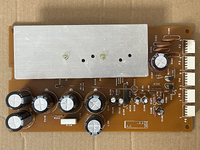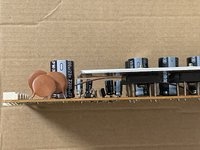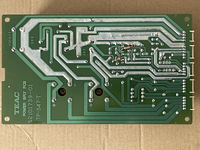I agree, it looks like the power supply PCB assembly was recapped…I can’t verify all the caps were replaced…maybe you can. And I can’t verify the correct values were used, so you may want to double-check that against the parts list or schematic. So that’s probably what I would do first, just to verify that.
The real thing to do here is to probe the power supply outputs with an oscilloscope to look for AC components on the DC power rails. The DC power rails, and we are talking particularly about the +/-15V rails for the audio circuitry, should be clean DC and stable. When filter caps fail on a linear power supply, that can allow a large amount of AC ripple to make it through to the power supply output. And by fail I mean drift out of spec enough that the filter cap can’t keep up with the time constant of the AC wave. And this can be the case if the caps weren’t replaced with caps of the proper value too. The other thing that can happen is a bridge rectifier can go bad. But the way to know this is to scope the rails.
The reason I’m steering you to the power supply first is…that’s what you do. If you’re having trouble with a device, it’s never wrong to start by verifying the power supply is doing the correct power supply things…outputting the correct type and voltage of power, and that it is stable and clean. And in your case, because you have hum, and what sounds like 120Hz hum, across all your outputs, I’d definitely be starting at the head waters and checking out the power supply. I wasn’t daunted by the fact your headphone out was initially reported as clean. I suspected if things were setup to verify that, when cranked you’d hear the hum. And even if you didn’t that still wouldn’t dissuade me from checking the power supply. Here’s why: all the active devices in the audio path, like the opamps, are powered by the same +/-15V power rails. Active devices like opamps have the ability, to varying degrees depending on the part, to reject stuff like AC ripple or noise in the power supply. This is what the CMRR spec of a part references. But if it’s too much ripple it exceeds the part’s ability to reject the noise and it passes through the part into its output(s)…the headphone amp is made up of a pair of 386 opamps, one for each channel. These 386 parts are powered by +6V. So there is a 7806 regulator in series with the +15V power rail upstream of the 386 parts…+15V at the input, +6V at the output. Regulators like the 78xx series are designed to deal with some AC ripple at their input, and output clean DC. You’ll find it typical in a garden-variety linear power supply it goes from power transformer to rectifier, then primary filter caps and often secondary smaller filter caps, then the regulator. There is a normal amount of ripple at the output of the rectifier, and still some after the primary and secondary filters…the regulator does the rest, and then there ideally should be another small filter cap at the output of the regulator and then a small value film cap at the end of the line to shunt HF noise. And then as the power goes to each PCB assembly you often see small filter caps along with sometimes a film cap where the power comes into each PCB for more filtering. And if the design engineers got their way over the bean counters you might even see filter caps at each opamp’s or group of opamps’ power supply inputs for filtering right at each device…I suspect you have a failure of some component or components in your power supply affecting one or both audio power rails, but the headphone amp’s 7806 regulator is dealing with some of that for the headphone circuit…plus there’s a 100uF filter cap at the output of the regulator. So the noise is less. But when you crank the headphone amp you can hear hum, yes? So the ripple is bad enough even all that can’t mitigate it.
SO…check to verify the part values on the recap job are correct. Verify each electrolytic cap was replaced. It’s rare, but even new caps can be off-spec. I’ve never had this issue with the Nichicon caps I use. But it’s possible. Do you have or know anybody with an oscilloscope? You can reinstall the power supply PCB, tip the 388 on its side, remove the bottom panel and access the solder joints on the motherboard for the outputs of the +/-15V rails and scope them right there. This doesn’t give you the ability to trace upstream and find the specific fault…you’d have to have the extender board or make a set of extender cables for the power supply so you could have it connected but out of the machine to access the whole PCB assembly, but probing the outputs will give you a good start to identify if the power supply is throwing ripple. As a more coarse test, if you have a multimeter, you can set it to AC volts, put the common probe on the ground pin of the power rails’ outputs, and then check the +15V and then -15V outputs with the other probe. There should ideally be 0.00V AC at the outputs.
Hope that helps.




